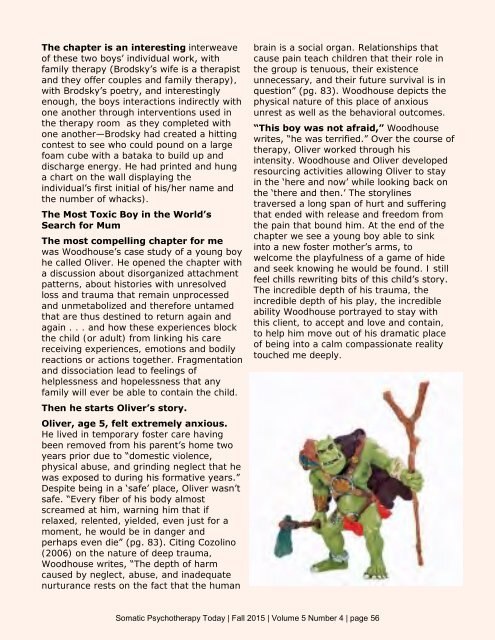Somatic Psychotherapy Today
1RCP3xp
1RCP3xp
You also want an ePaper? Increase the reach of your titles
YUMPU automatically turns print PDFs into web optimized ePapers that Google loves.
The chapter is an interesting interweave<br />
of these two boys’ individual work, with<br />
family therapy (Brodsky’s wife is a therapist<br />
and they offer couples and family therapy),<br />
with Brodsky’s poetry, and interestingly<br />
enough, the boys interactions indirectly with<br />
one another through interventions used in<br />
the therapy room as they completed with<br />
one another—Brodsky had created a hitting<br />
contest to see who could pound on a large<br />
foam cube with a bataka to build up and<br />
discharge energy. He had printed and hung<br />
a chart on the wall displaying the<br />
individual’s first initial of his/her name and<br />
the number of whacks).<br />
The Most Toxic Boy in the World’s<br />
Search for Mum<br />
The most compelling chapter for me<br />
was Woodhouse’s case study of a young boy<br />
he called Oliver. He opened the chapter with<br />
a discussion about disorganized attachment<br />
patterns, about histories with unresolved<br />
loss and trauma that remain unprocessed<br />
and unmetabolized and therefore untamed<br />
that are thus destined to return again and<br />
again . . . and how these experiences block<br />
the child (or adult) from linking his care<br />
receiving experiences, emotions and bodily<br />
reactions or actions together. Fragmentation<br />
and dissociation lead to feelings of<br />
helplessness and hopelessness that any<br />
family will ever be able to contain the child.<br />
Then he starts Oliver’s story.<br />
Oliver, age 5, felt extremely anxious.<br />
He lived in temporary foster care having<br />
been removed from his parent’s home two<br />
years prior due to “domestic violence,<br />
physical abuse, and grinding neglect that he<br />
was exposed to during his formative years.”<br />
Despite being in a ‘safe’ place, Oliver wasn’t<br />
safe. “Every fiber of his body almost<br />
screamed at him, warning him that if<br />
relaxed, relented, yielded, even just for a<br />
moment, he would be in danger and<br />
perhaps even die” (pg. 83). Citing Cozolino<br />
(2006) on the nature of deep trauma,<br />
Woodhouse writes, “The depth of harm<br />
caused by neglect, abuse, and inadequate<br />
nurturance rests on the fact that the human<br />
brain is a social organ. Relationships that<br />
cause pain teach children that their role in<br />
the group is tenuous, their existence<br />
unnecessary, and their future survival is in<br />
question” (pg. 83). Woodhouse depicts the<br />
physical nature of this place of anxious<br />
unrest as well as the behavioral outcomes.<br />
“This boy was not afraid,” Woodhouse<br />
writes, “he was terrified.” Over the course of<br />
therapy, Oliver worked through his<br />
intensity. Woodhouse and Oliver developed<br />
resourcing activities allowing Oliver to stay<br />
in the ‘here and now’ while looking back on<br />
the ‘there and then.’ The storylines<br />
traversed a long span of hurt and suffering<br />
that ended with release and freedom from<br />
the pain that bound him. At the end of the<br />
chapter we see a young boy able to sink<br />
into a new foster mother’s arms, to<br />
welcome the playfulness of a game of hide<br />
and seek knowing he would be found. I still<br />
feel chills rewriting bits of this child’s story.<br />
The incredible depth of his trauma, the<br />
incredible depth of his play, the incredible<br />
ability Woodhouse portrayed to stay with<br />
this client, to accept and love and contain,<br />
to help him move out of his dramatic place<br />
of being into a calm compassionate reality<br />
touched me deeply.<br />
<strong>Somatic</strong> <strong>Psychotherapy</strong> <strong>Today</strong> | Fall 2015 | Volume 5 Number 4 | page 56


